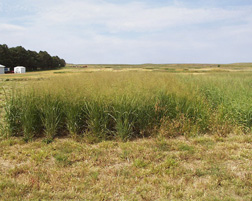This page has been archived and is being provided for reference purposes only. The page is no longer being updated, and therefore, links on the page may be invalid.
Read the magazine story to find out more. |
|
Energy Farming With Switchgrass Saves Carbon
By Don ComisJuly 19, 2006
Agricultural Research Service scientist Mark Liebig has discovered how the potential bioenergy crop switchgrass stores more soil carbon than its competitor for ethanol production, corn. His studies show that a greater abundance of deep roots under switchgrass acts to increase soil carbon levels. Boosting carbon storage in the soil mitigates the greenhouse effect and improves soil quality
While previous studies only measured carbon retained in the top foot of soil, Liebig, rangeland scientist Holly Johnson and other ARS colleagues sampled down to four feet beneath fields of switchgrass, corn and wheat on 42 farms in North Dakota, South Dakota and Minnesota. Liebig is a soil scientist at the ARS Northern Great Plains Research Laboratory in Mandan, N.D.
Switchgrass—a warm-season perennial indigenous to America's native tallgrass prairie—has been identified as a promising bioenergy crop because of the wide range of conditions under which it can grow. There is interest in converting switchgrass biomass into ethanol for use as a biofuel or burning it to generate electricity.
Liebig found that switchgrass fields had an average of about seven tons more soil carbon per acre than nearby corn and wheat fields. Greater soil carbon under switchgrass was observed at all depths, but it was most pronounced at one to three feet down—a depth in the soil profile where switchgrass has more root biomass than corn or wheat. Switchgrass roots grow as long as eight feet, compared to three to six feet for corn and wheat.
The sites Liebig and Johnson studied are representative of about 74 million acres of the Northern Plains and northern Corn Belt. Evaluations of switchgrass are being conducted to determine if this deep storage of soil carbon holds true elsewhere.
Read more about the research in the July 2006 issue of Agricultural Research magazine.
ARS is the U.S. Department of Agriculture’s chief scientific research agency.

